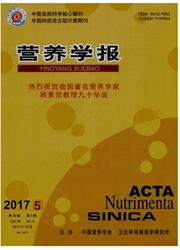

 中文摘要:
中文摘要:
目的分析广州居民膳食n-3脂肪酸摄入水平与血脂的关系。方法志愿者形式招募40~75岁广州市民,采用定量食物频数问卷调查研究对象每日食物摄入种类及数量,计算能量及营养素,特别是n-3脂肪酸含量。检测空腹血脂4项。将膳食n-3脂肪酸摄入量四分位分组分析其与血脂的相关关系。结果共招募3974名研究对象,其膳食总能量摄入量为(7.68±2.24)MJ/d、脂肪供能比为(33.1±7.8)%,饱和脂肪酸供能比为(8.3±2.2)%。膳食n-3脂肪酸摄入量为(1.29±1.02)g/d,其中α-亚麻酸(ALA)为(1.18±0.99)g/d[(0.58±0.42)%energy],二十碳五烯酸(EPA)和二十二碳六烯酸(DHA)为(99.50±103.09)mg/d。校正年龄、性别、BMI、总能量、饱和脂肪酸及膳食n-6脂肪酸摄入量等混杂因素后,膳食ALA摄入量与空腹血清总胆固醇(TC)、甘油三酯(TG)、高密度脂蛋白胆固醇(HDL-C)及低密度脂蛋白胆固醇(LDL-C)呈剂量依赖的负相关关系(P〈0.05),Q4(2.23g/d)的TC、HDL-C及LDL-C显著低于Q1(0.47g/d)(P〈0.05);膳食EPA+DHA摄入量与TG及HDL-C也呈线性负相关关系(P﹤0.05),Q1(26.40 mg/d)的TG及HDL-C水平显著高于其他3组(P〈0.05)。结论与ALA和EPA+DHA摄入量分别为0.47 g/d和26.40 mg/d相比,摄入量达到2.23 g/d和200.30 mg/d时有利于将血脂维持在较低水平。
 英文摘要:
英文摘要:
Objective To investigate the associations betweens dietary n-3 fatty acid consumption and serum lipids in middle-aged and older adults in Guangzhou. Methods In this cross-sectional study, 3974 Guangzhou residents aged between 40-75 years were enrolled. Dietary n-3 fatty acids and other nutrients intakes were assessed by quantitative food frequency questionnaire(FFQ). Fasting serum total cholesterol(TC), triglycerides(TG), low density lipoprotein cholesterol(LDL-C), high density lipoprotein cholesterol(HDL-C) were detected. Results The daily dietary energy intake was(7.68±2.24) MJ. Fat energy ratio was(33.1±7.8)%, and saturated fat energy ratio was(8.3±2.2)%. Total daily dietary n-3 fatty acid consumption was(1.29±1.02)g, in which linolenic acid(ALA) intake was(1.18±0.99)g [(0.58±0.42)% energy] and eicosapntemacnioc acid(EPA)+docosehexaenoic acid(DHA) was(99.50±103.09) mg. After adjustment for age, sex, BMI, total energy, saturated fatty acids and n-6 fatty acids intakes and other confounders, dietary ALA was inversely associated with serum TC, TG, HDL-C, and LDL-C(P〈0.05). Compared with the lowest quartile(0.47 g/d), subjects in the highest quartile(2.23 g/d) had lower levels of TC, HDL-C, and LDL-C(P〈0.05). Dietary EPA+DHA was also inversely associated with TG and HDL-C(P〈0.05). The levels of TG and HDL-C were significantly decreased in the higher three quartiles than that in the lowest quartile(26.40 mg/d)(P〈0.05). Conclusion Subjects with higher consumptions of ALA(2.23 g/d) and EPA+DHA (200.30 mg/d) had lower levels of serum lipids than those with lower consumptions of ALA(0.47 g/d) and EPA+DHA(26.40 mg/d).
 同期刊论文项目
同期刊论文项目
 同项目期刊论文
同项目期刊论文
 期刊信息
期刊信息
